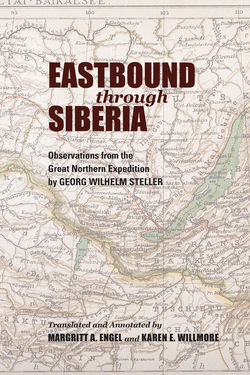Читать книгу Eastbound through Siberia - Georg Wilhelm Steller - Страница 8
ОглавлениеWE GRATEFULLY ACKNOWLEDGE THE HELP AND SUPPORT OF many people in our third Steller translation project. Foremost among them are Dr. Wieland Hintzsche, discoverer of lost documents and editor-in-chief of Quellen zur Geschichte Sibiriens und Alaskas aus russischen Archiven, and his wife and staunchest supporter, Dr. Elisabeth Hintzsche, a physician and the president of the International Georg-Wilhelm-Steller Society, which they founded twenty-two years ago together with scholars from the St. Petersburg Academy of Sciences. Under the auspices of the society, the Hintzsches have organized annual “German-Russian Encounters” in Halle, at which international scholars explore and share a multitude of topics related to the eighteenth-century history of Siberia and Alaska. While Elisabeth has been the driving force behind these and other regular Society-sponsored events, Wieland has shepherded the documents he located in Russian archives into print (fifteen volumes so far). His single-handed transcription of Steller’s manuscripts in itself has been a monumental task we stand in awe of. For their devotion to Steller and all the encouragement given us, we salute and thank them both.
We owe Dr. Dr. h. c. Eckehart J. Jäger, Professor Emeritus of the Department of Biology (Geobotany und Botanical Garden), Martin-Luther-Universität, Halle, Germany, special thanks for his stellar help with Steller on several fronts. He graciously shared his botanical expertise and donated an enormous amount of time to hunting down the current scientific names of the some 155 plants Steller mentioned, who sometimes described the plant in detail, more often with just a few characteristics, occasionally with just one word. This identification process alone was a huge undertaking, especially considering how DNA analysis is changing how some plants are classified. It is one we could never have done ourselves. Unasked, Professor Jäger also edited our translation for accuracy, comparing our English with Steller’s German, aided us in the transliteration of the Russian, drew and labeled the maps of Steller’s journey, and reviewed the galley proofs for late-minute changes in classification. Finally, he described Steller’s place in the history of botany. We are immeasurably thankful for his contribution, including for his and his wife’s hospitality during our stays in Germany.
It is to Dr. O. W. (Jack) Frost, Professor Emeritus of Alaska Pacific University, Anchorage, AK, that we owe our involvement with Steller in the first place. Thirty-five years ago he asked for help in a new translation of Steller’s Sea voyage, beginning with unpublished Steller manuscripts found in the Smithsonian. Frost’s passion for all things Steller, culminating in his book, Bering: The Russian Discovery of America, started us on our own Steller journey.
We gratefully acknowledge the pictorial contributions of Ann Arnold, artist and writer, who graciously allowed us to use illustrations from her book Sea Cows, Shamans, and Scurvy; of Ilya Vyuev, Russian sculptor, and his wife, Inna Lipilina, who provided a photo of his Steller statue to use as frontispiece; of Drs. Irina Tunkina and Larissa Bondar, of the Russian Academy of Sciences, St, Petersburg branch, who located and gave us permission to use the sample of Steller’s handwriting; and of Wikimedia Commons, which provided the other two illustrations.
While we relied primarily on Hintzsche’s notes and Jäger’s expertise in dealing with Steller’s unorthodox use of the Russian language, local Russian teachers Delynne Chambers and Leonid Kokaurov; the late Dr. Roman R. Tchaikovski (Professor Emeritus of German and English, Northern International University, Magadan, Russia), and Professor Dr. Swetlana Mengel (Martin-Luther-Universität Halle-Wittenberg, Seminar für Slavistik) helped us solve particular vocabulary puzzles.
For answers to other, primarily scientific, questions we turned for help to Dr. Robin A. Beebee, hydrologist for the US Geological Survey in Anchorage, who answered our questions about the accuracy of some of Steller’s topographical descriptions; to Archpriest Michael J. Oleksa, Dean of St. Michael’s Cathedral, Sitka, AK, who untangled the names of the Russian Orthodox churches Steller describes in Irkutsk and explained the religious terminology; to the late Heinrich Springer, a well-known Alaskan ornithologist, who happily identified the birds Steller mentions; and to Dr. Richard VanderHoek, archeologist for the Department of Natural Resources, State of Alaska, who helped with identifying the sheets of ice Steller describes, particularly those now known as ice patches. We thank them all for their help. We also gratefully acknowledge the posthumous assistance of the late Dr. Carl E. Bond, Professor Emeritus, Department of Fisheries and Wildlife, Oregon State University, who had identified the fish Steller mentions and describes in his Kamchatka manuscript, some of which we have used in this translation.
Last but not least we express our sincere appreciation for the assistance rendered by the Indiana University Press team who shepherded our work through the publication process, especially Jennika Baines, Acquisitions Editor, who enthusiastically recommended it for publication; Darja Malcolm-Clarke, Editorial Project Manager, who coordinated the publication process; Pete Feely, Amnet’s Project Manager, who made sure we did not get hopelessly tangled up in the copyediting process; and Lizzie Troyer, the copyeditor, who managed to remove all our inconsistencies.
Not to be forgotten, we offer a huge thank-you to our families for goodhumoredly tolerating our years-long preoccupation with Georg Wilhelm Steller and for patiently and wholeheartedly supporting us.
